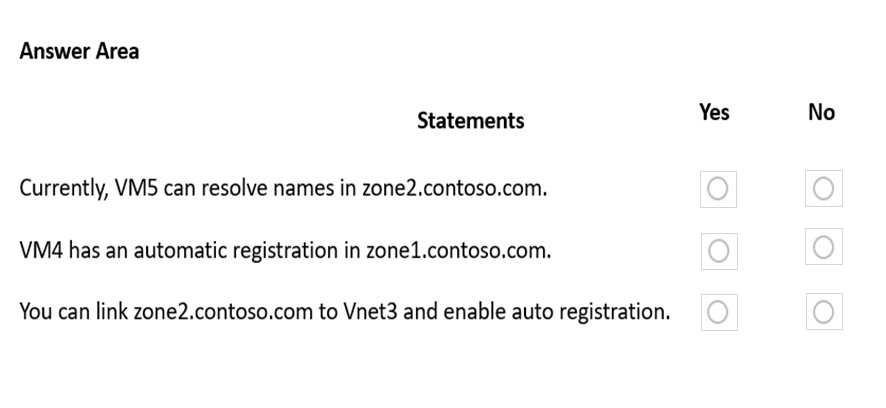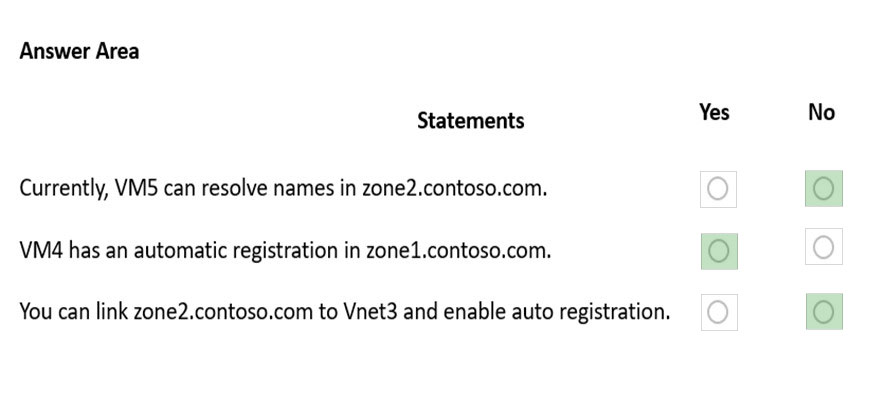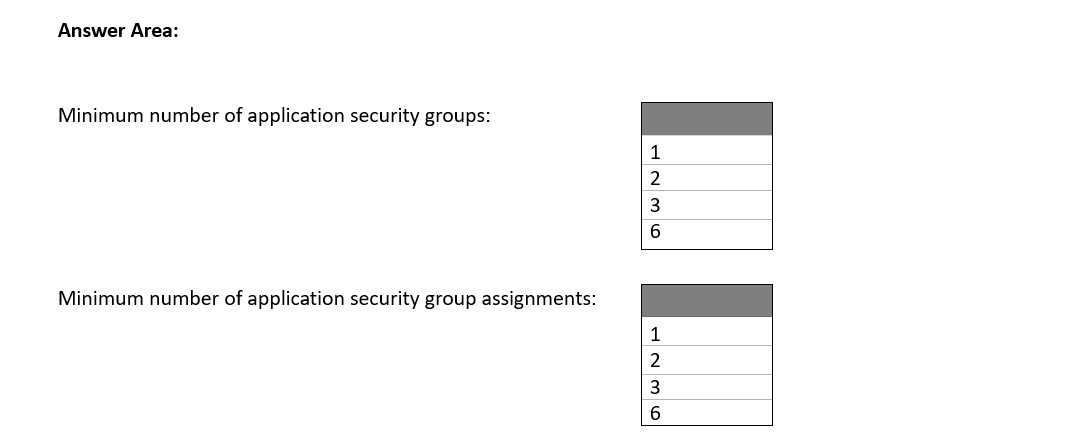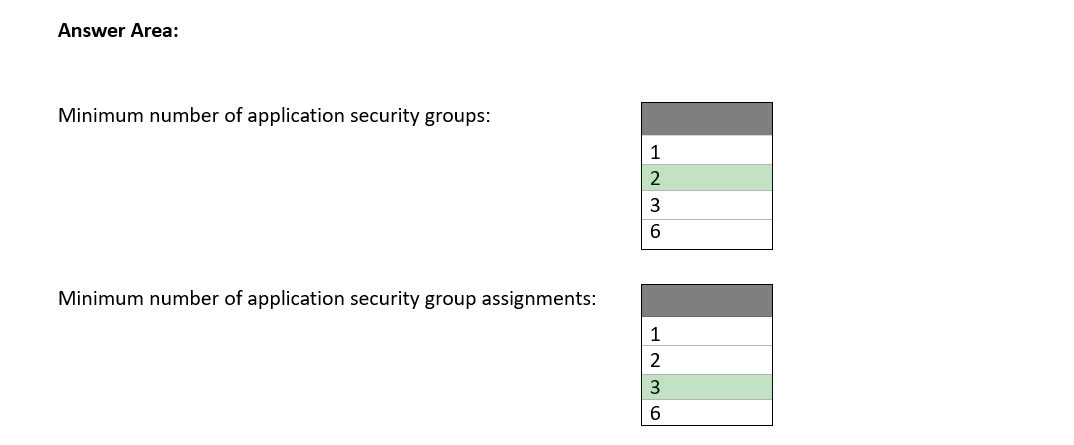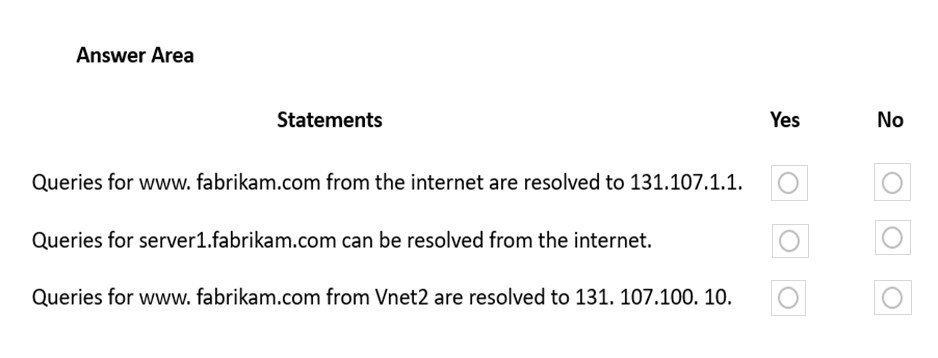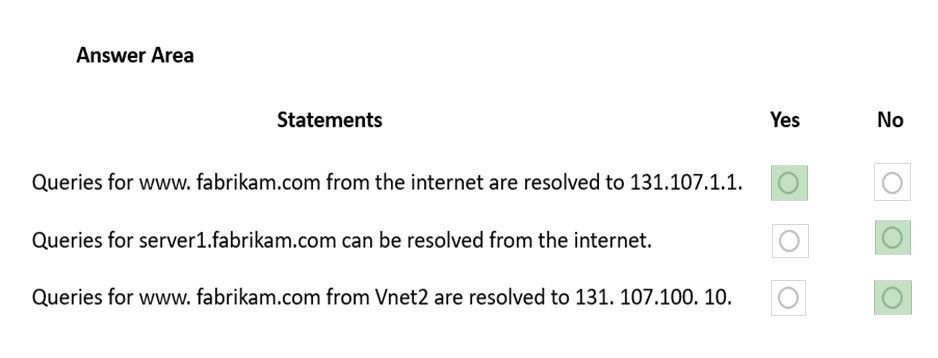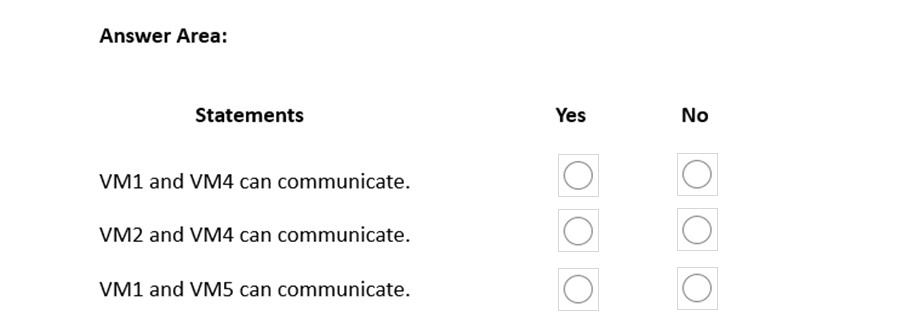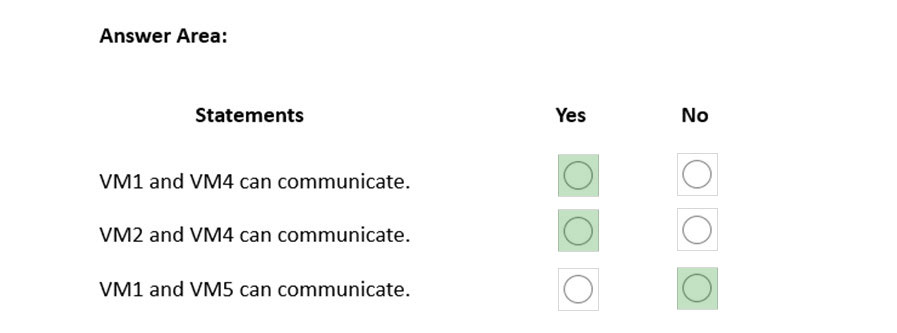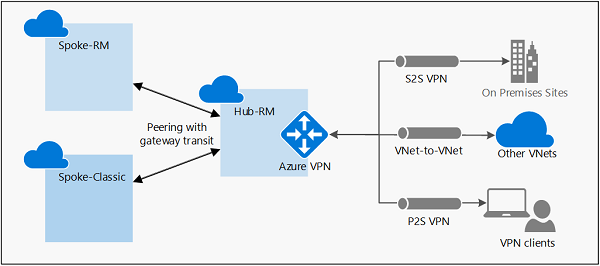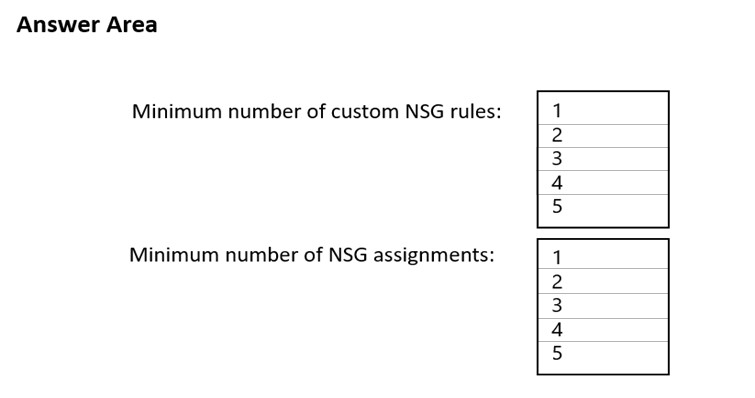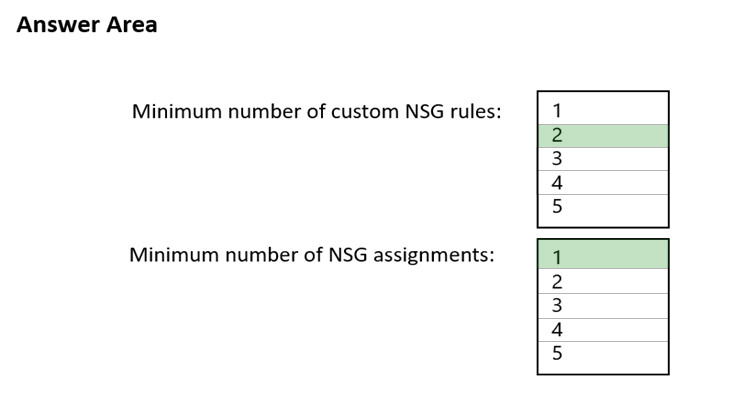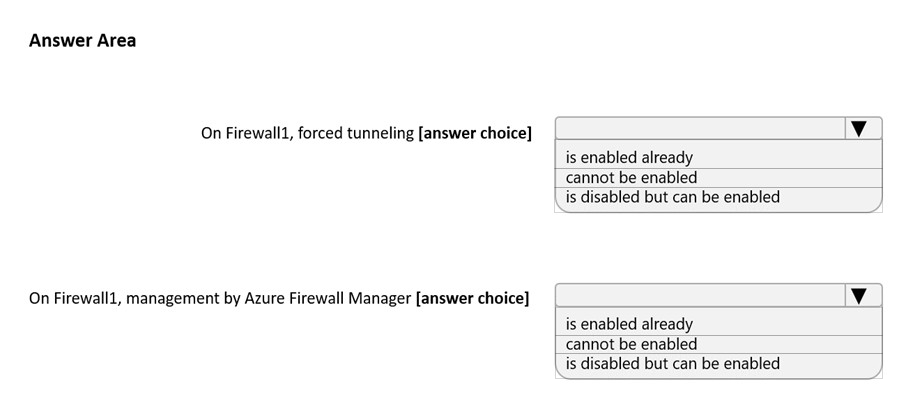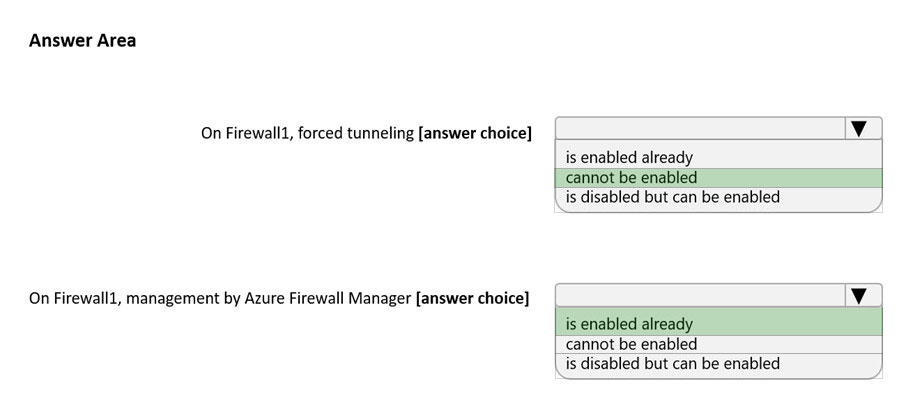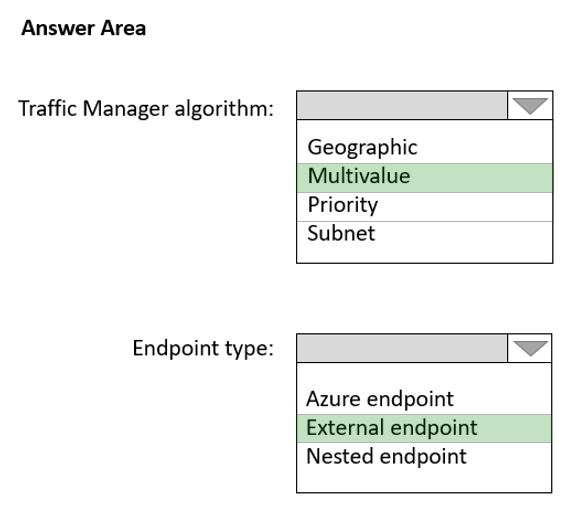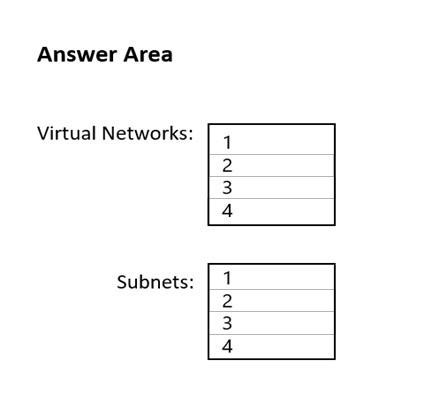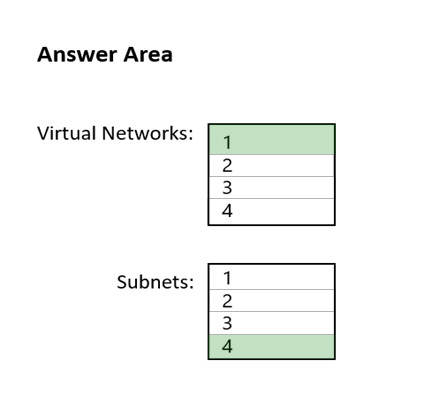AZ-700 Mock Test Free – 50 Realistic Questions to Prepare with Confidence.
Getting ready for your AZ-700 certification exam? Start your preparation the smart way with our AZ-700 Mock Test Free – a carefully crafted set of 50 realistic, exam-style questions to help you practice effectively and boost your confidence.
Using a mock test free for AZ-700 exam is one of the best ways to:
- Familiarize yourself with the actual exam format and question style
- Identify areas where you need more review
- Strengthen your time management and test-taking strategy
Below, you will find 50 free questions from our AZ-700 Mock Test Free resource. These questions are structured to reflect the real exam’s difficulty and content areas, helping you assess your readiness accurately.
You have an Azure virtual network that contains the subnets shown in the following table.You deploy an Azure firewall to AzureFirewallSubnet. You route all traffic from Subnet2 through the firewall. You need to ensure that all the hosts on Subnet2 can access an external site located at https://*.contoso.com. What should you do?
A. In a firewall policy, create a DNAT rule.
B. Create a network security group (NSG) and associate the NSG to Subnet2.
C. In a firewall policy, create a network rule.
D. In a firewall policy, create an application rule.
HOTSPOT - For each of the following statements, select Yes if the statement is true. Otherwise, select No. NOTE: Each correct selection is worth one point. Hot Area:
Your company has four branch offices and an Azure subscription. The subscription contains an Azure VPN gateway named GW1. The branch offices are configured as shown in the following table.The branch office routers provide internet connectivity and Site-to-Site VPN connections to GW1. The users in Branch1 report that they can connect to internet resources, but cannot access Azure resources. You need to ensure that the Branch1 users can connect to the Azure resources. The solution must meet the following requirements: • Minimize downtime for all users. • Minimize administrative effort. What should you do first?
A. Recreate LNG1.
B. Reset RTR1.
C. Reset Connection1.
D. Reset GW1.
You have the Azure virtual networks shown in the following table.You have the Azure resources shown in the following table.
You need to check latency between the resources by using connection monitors in Azure Network Watcher. What is the minimum number of connection monitors that you must create?
A. 1
B. 2
C. 3
D. 4
E. 5
After you answer a question in this section, you will NOT be able to return it. As a result, these questions will not appear in the review screen. You have an Azure subscription that contains an Azure Virtual WAN named VWAN1. VWAN1 contains a hub named Hub1. Hub1 has a security status of Unsecured. You need to ensure that the security status of Hub1 is marked as Secured. Solution: You implement Azure Firewall. Does this meet the requirement?
A. Yes
B. No
After you answer a question in this section, you will NOT be able to return to it. As a result, these questions will not appear in the review screen. You have an Azure subscription that contains the following resources: ✑ A virtual network named Vnet1 ✑ A subnet named Subnet1 in Vnet1 ✑ A virtual machine named VM1 that connects to Subnet1 ✑ Three storage accounts named storage1, storage2, and storage3 You need to ensure that VM1 can access storage1. VM1 must be prevented from accessing any other storage accounts. Solution: You configure the firewall on storage1 to only accept connections from Vnet1. Does this meet the goal?
A. Yes
B. No
SIMULATION -Username and password - Use the following login credentials as needed: To enter your username, place your cursor in the Sign in box and click on the username below. To enter your password, place your cursor in the Enter password box and click on the password below. Azure Username: User-12345678@cloudslice.onmicrosoft.com Azure Password: xxxxxxxxxx - If the Azure portal does not load successfully in the browser, press CTRL-K to reload the portal in a new browser tab. The following information is for technical support purposes only: Lab Instance: 12345678 - You need to ensure that only hosts on VNET1 can access the storage123456789 storage account. The solution must ensure that access occurs over the Azure backbone network. To complete this task, sign in to the Azure portal.
HOTSPOT - You have an Azure virtual network named Vnet1 that contains two subnets named Subnet1 and Subnet2. Both subnets contain virtual machines. You create a NAT gateway named NATgateway1 as shown in the following exhibit.Use the drop-down menus to select the answer choice that completes each statement based on the information presented in the graphic. NOTE: Each correct selection is worth one point.
SIMULATION -Username and password - Use the following login credentials as needed: To enter your username, place your cursor in the Sign in box and click on the username below. To enter your password, place your cursor in the Enter password box and click on the password below. Azure Username: User-12345678@cloudslice.onmicrosoft.com Azure Password: xxxxxxxxxx - If the Azure portal does not load successfully in the browser, press CTRL-K to reload the portal in a new browser tab. The following information is for technical support purposes only: Lab Instance: 12345678 - You plan to implement an Azure application gateway in the East US Azure region. The application gateway will have Web Application Firewall (WAF) enabled. You need to create a policy that can be linked to the planned application gateway. The policy must block connections from IP addresses in the 131.107.150.0/24 range. You do NOT need to provision the application gateway to complete this task. To complete this task, sign in to the Azure portal.
HOTSPOT - You have an Azure subscription that contains the virtual machines shown in the following table.VNet1 and VNet2 are NOT connected to each other. You need to block traffic from SQL Server 2019 to IIS by using application security groups. The solution must minimize administrative effort. How should you configure the application security groups? To answer, select the appropriate options in the answer area. NOTE: Each correct selection is worth one point. Hot Area:
HOTSPOT - You have the network topology shown in the Topology exhibit. (Click the Topology tab.)You have the Azure firewall shown in the Firewall1 exhibit. (Click the Firewall1 tab.)
You have the route table shown in the RouteTable1 exhibit. (Click the RouteTable1 tab.)
For each of the following statements, select Yes if the statement is true. Otherwise, select No. NOTE: Each correct selection is worth one point. Hot Area:
You need to provide access to storage1. The solution must meet the PaaS networking requirements and the business requirements. What should you include in the solution?
A. a private endpoint
B. Azure Traffic Manager
C. Azure Front Door
D. a service endpoint
You have an Azure subscription that contains the following resources: • A virtual network named Vnet1 • Two subnets named subnet1 and AzureFirewallSubnet • A public Azure Firewall named FW1 • A route table named RT1 that is associated to Subnet1 • A rule routing of 0.0.0.0/0 to FW1 in RT1 After deploying 10 servers that run Windows Server to Subnet1, you discover that none of the virtual machines were activated. You need to ensure that the virtual machines can be activated. What should you do?
A. On FW1, create an outbound service tag rule for AzureCloud.
B. Deploy an Azure Standard Load Balancer that has an outbound NAT rule.
C. On FW1, create an outbound network rule that allows traffic to the Azure Key Management Service (KMS).
D. To Subnet1, associate a network security group (NSG) that allows outbound access to port 1688.
DRAG DROP - You have an Azure subscription that contains the resources shown in the following table.The IP Addresses settings for Vnet1 are configured as shown in the exhibit.
You need to ensure that you can integrate WebApp1 and Vnet1. Which three actions should you perform in sequence before you can integrate WebApp1 and Vnet1? To answer, move the appropriate actions from the list of actions to the answer area and arrange them in the correct order. Select and Place:
You are planning an Azure Point-to-Site (P2S) VPN that will use OpenVPN. Users will authenticate by an on-premises Active Directory domain. Which additional service should you deploy to support the VPN authentication?
A. an Azure key vault
B. a RADIUS server
C. a certification authority
D. Azure Active Directory (Azure AD) Application Proxy
You have a hybrid environment that uses ExpressRoute to connect an on-premises network and Azure. You need to log the uptime and the latency of the connection periodically by using an Azure virtual machine and an on-premises virtual machine. What should you use?
A. Azure Monitor
B. IP flow verify
C. Connection Monitor
D. Azure Internet Analyzer
You have five virtual machines that run Windows Server. Each virtual machine hosts a different web app. You plan to use an Azure application gateway to provide access to each web app by using a hostname of www.contoso.com and a different URL path for each web app, for example: https://www.contoso.com/app1. You need to control the flow of traffic based on the URL path. What should you configure?
A. HTTP settings
B. listeners
C. rules
D. rewrites
SIMULATION -Username and password - Use the following login credentials as needed: To enter your username, place your cursor in the Sign in box and click on the username below. To enter your password, place your cursor in the Enter password box and click on the password below. Azure Username: User-12345678@cloudslice.onmicrosoft.com Azure Password: xxxxxxxxxx - If the Azure portal does not load successfully in the browser, press CTRL-K to reload the portal in a new browser tab. The following information is for technical support purposes only: Lab Instance: 12345678 - You have two servers that are each hosted by a separate service provider in New York and California. The server hosted in New York is accessible by using a host name of ny.contoso.com. The server hosted in California is accessible by using a host name of ca.contoso.com. You need to implement an Azure solution to route users to the server that has the lowest latency. The solution must minimize costs. To complete this task, sign in to the Azure portal.
HOTSPOT - You have the Azure resources shown in the following table.You need to link VNet2 to Circuit1. What should you create in each subscription? To answer, select the appropriate options in the answer area. NOTE: Each correct selection is worth one point.
You have an Azure subscription that contains the virtual networks shown in the following table.You plan to deploy an Azure firewall named AF1 to RG1 in the West US Azure region. To which virtual networks can you deploy AF1?
A. Vnet1 and Vnet4 only
B. Vnet1, Vnet2, Vnet3, and Vnet4
C. Vnet1 only
D. Vnet1 and Vnet2 only
E. Vnet1, Vnet2, and Vnet4 only
Your company has an on-premises network and three Azure subscriptions named Subscription1, Subscription2, and Subscription3. The departments at the company use the Azure subscriptions as shown in the following table.All the resources in the subscriptions are in either the West US Azure region or the West US 2 Azure region. You plan to connect all the subscriptions to the on-premises network by using ExpressRoute. What is the minimum number of ExpressRoute circuits required?
A. 1
B. 2
C. 3
D. 4
E. 5
SIMULATION -Username and password - Use the following login credentials as needed: To enter your username, place your cursor in the Sign in box and click on the username below. To enter your password, place your cursor in the Enter password box and click on the password below. Azure Username: User-12345678@cloudslice.onmicrosoft.com Azure Password: xxxxxxxxxx - If the Azure portal does not load successfully in the browser, press CTRL-K to reload the portal in a new browser tab. The following information is for technical support purposes only: Lab Instance: 12345678 - You need to ensure that requests for www.relecloud.com from any of your Azure virtual networks resolve to frontdoor1.azurefd.net. To complete this task, sign in to the Azure portal.
HOTSPOT - Overview - Contoso, Ltd. is a consulting company that has a main office in San Francisco and a branch office in Dallas. Contoso recently purchased an Azure subscription and is performing its first pilot project in Azure. Existing Environment - Azure Network Infrastructure - Contoso has an Azure Active Directory (Azure AD) tenant named contoso.com. The Azure subscription contains the virtual networks shown in the following table.Vnet1 contains a virtual network gateway named GW1. Azure Virtual Machines - The Azure subscription contains virtual machines that run Windows Server 2019 as shown in the following table.
The NSGs are associated to the network interfaces on the virtual machines. Each NSG has one custom security rule that allows RDP connections from the internet. The firewall on each virtual machine allows ICMP traffic. An application security group named ASG1 is associated to the network interface of VM1. Azure Network Infrastructure Diagram
Azure Private DNS Zones - The Azure subscription contains the Azure private DNS zones shown in the following table.
Zone1.contoso.com has the virtual network links shown in the following table.
Other Azure Resources - The Azure subscription contains additional resources as shown in the following table.
Requirements - Virtual Network Requirements - Contoso has the following virtual network requirements: • Create a virtual network named Vnet6 in West US that will contain the following resources and configurations: o Two container groups that connect to Vnet6 o Three virtual machines that connect to Vnet6 o Allow VPN connections to be established to Vnet6 o Allow the resources in Vnet6 to access KeyVault1, DB1, and Vnet1 over the Microsoft backbone network. • The virtual machines in Vnet4 and Vnet5 must be able to communicate over the Microsoft backbone network. • A virtual machine named VM-Analyze will be deployed to Subnet1. VM-Analyze must inspect the outbound network traffic from Subnet2 to the internet. Network Security Requirements - Contoso has the following network security requirements: • Configure Azure Active Directory (Azure AD) authentication for Point-to-Site (P2S) VPN users. • Enable NSG flow logs for NSG3 and NSG4. • Create an NSG named NSG10 that will be associated to Vnet1/Subnet1 and will have the custom inbound security rules shown in the following table.
• Create an NSG named NSG11 that will be associated to Vnet1/Subnet2 and will have the custom outbound security rules shown in the following table.
Which virtual machines can VM1 and VM4 ping successfully before NSG10 and NSG11 are created? To answer, select the appropriate options in the answer area. NOTE: Each correct selection is worth one point.
HOTSPOT - You have an Azure subscription that contains two virtual networks named Vnet1 and Vnet2. You register a public DNS zone named fabrikam.com. The zone is configured as shown in the Public DNS Zone exhibit.You have a private DNS zone named fabrikam.com. The zone is configured as shown in the Private DNS Zone exhibit.
You have a virtual network link configured as shown in the Virtual Network Link exhibit.
For each of the following statements, select Yes if the statement is true. Otherwise, select No. NOTE: Each correct selection is worth one point. Hot Area:
Overview - Litware, Inc. is a financial company that has a main datacenter in Boston and 20 branch offices across the United States. Users have Android, iOS, and Windows 10 devices. Existing Environment - Hybrid Environment - The on-premises network contains an Active Directory forest named litwareinc.com that syncs to an Azure Active Directory (Azure AD) tenant named litwareinc.com by using Azure AD Connect. All offices connect to a virtual network named Vnet1 by using a Site-to-Site VPN connection. Azure Environment - Litware has an Azure subscription named Sub1 that is linked to the litwareinc.com Azure AD tenant. Sub1 contains resources in the East US Azure region as shown in the following table.A diagram of the resource in the East US Azure region is shown in the Azure Network Diagram exhibit. There is bidirectional peering between Vnet1 and Vnet2. There is bidirectional peering between Vnet1 and Vnet3. Currently, Vnet2 and Vnet3 cannot communicate directly. Azure Network Diagram -
Requirements - Business Requirements - Litware wants to minimize costs whenever possible, as long as all other requirements are met. Virtual Networking Requirements - Litware identifies the following virtual networking requirements: • Direct the default route of 0.0.0.0/0 on Vnet2 and Vnet3 to the Boston datacenter over an ExpressRoute circuit. • Ensure that the records in the cloud.litwareinc.com can be resolved from the on-premises locations. • Automatically register the DNS names of Azure virtual machines to the cloud.litwareinc.com zone. • Minimize the size of the subnets allocated to platform-managed services. • Allow traffic from VMScaleSet1 to VMScaleSet2 on the TCP port 443 only. Hybrid Networking Requirements - Litware identifies the following hybrid networking requirements: • Users must be able to connect to Vnet1 by using a Point-to-Site (P2S) VPN when working remotely. Connections must be authenticated by Azure AD. • Latency of the traffic between the Boston datacenter and all the virtual networks must be minimized. • The Boston datacenter must connect to the Azure virtual networks by using an ExpressRoute FastPath connection. • Traffic between Vnet2 and Vnet3 must be routed through Vnet1. PaaS Networking Requirements - Litware identifies the following networking requirements for platform as a service (PaaS): • The storage1 account must be accessible from all on-premises locations without exposing the public endpoint of storage1. • The storage2 account must be accessible from Vnet2 and Vnet3 without exposing the public endpoint of storage2. You need to connect Vnet2 and Vnet3. The solution must meet the virtual networking requirements and the business requirements. Which two actions should you include in the solution? Each correct answer presents part of the solution. NOTE: Each correct selection is worth one point.
A. On the peering from Vnet1, select Allow for Traffic forwarded from remote virtual network.
B. On the peerings from Vnet2 and Vnet3, select Allow for Traffic forwarded from remote virtual network.
C. On the peering from Vnet1, select Use the remote virtual network’s gateway or Route Server.
D. On the peering from Vnet1, select Allow for Traffic to remote virtual network.
E. On the peerings from Vnet2 and Vnet3, select Use the remote virtual network’s gateway or Route Server.
You are planning the IP addressing for the subnets in Azure virtual networks. Which type of resource requires IP addresses in the subnets?
A. storage account
B. internal load balancers
C. service endpoints
D. service endpoint policies
After you answer a question in this section, you will NOT be able to return to it. As a result, these questions will not appear in the review screen. You have two Azure virtual networks named Vnet1 and Vnet2. You have a Windows 10 device named Client1 that connects to Vnet1 by using a Point-to-Site (P2S) IKEv2 VPN. You implement virtual network peering between Vnet1 and Vnet2. Vnet1 allows gateway transit. Vnet2 can use the remote gateway. You discover that Client1 cannot communicate with Vnet2. You need to ensure that Client1 can communicate with Vnet2. Solution: You download and reinstall the VPN client configuration. Does this meet the goal?
A. Yes
B. No
SIMULATION -Username and password - Use the following login credentials as needed: To enter your username, place your cursor in the Sign in box and click on the username below. To enter your password, place your cursor in the Enter password box and click on the password below. Azure Username: User-12345678@cloudslice.onmicrosoft.com Azure Password: xxxxxxxxxx - If the Azure portal does not load successfully in the browser, press CTRL-K to reload the portal in a new browser tab. The following information is for technical support purposes only: Lab Instance: 12345678 - You plan to deploy several virtual machines to subnet1-2. You need to prevent all Azure hosts outside of subnet1-2 from connecting to TCP port 5585 on hosts on subnet1-2. The solution must minimize administrative effort. To complete this task, sign in to the Azure portal.
After you answer a question in this section, you will NOT be able to return to it. As a result, these questions will not appear in the review screen. You have an Azure subscription that contains an Azure Front Door Premium profile named AFD1 and an Azure Web Application Firewall (WAF) policy named WAF1. AFD1 is associated with WAF1. You need to configure a rate limit for incoming requests to AFD1. Solution: You add a rule to the rule set of AFD1. Does this meet the goal?
A. Yes
B. No
You have an Azure subscription that contains the public IP addresses shown in the following table.You plan to deploy a NAT gateway named NAT1. Which public IP addresses can be used as the public IP address for NAT1?
A. IP3 only
B. IP5 only
C. IP2 and IP4 only
D. IP1, IP3 and IP5 only
E. IP3 and IP5 only
HOTSPOT - You have the Azure environment shown in the exhibit.You have virtual network peering between Vnet1 and Vnet2. You have virtual network peering between Vnet4 and Vnet5. The virtual network peering is configured as shown in the following table.
For each of the following statements, select Yes if the statement is true. Otherwise, select No. Hot Area:
HOTSPOT - You need to restrict traffic from VMScaleSet1 to VMScaleSet2. The solution must meet the virtual networking requirements. What is the minimum number of custom NSG rules and NSG assignments required? To answer, select the appropriate options in the answer area. NOTE: Each correct selection is worth one point. Hot Area:
You plan to publish a website that will use an FQDN of www.contoso.com. The website will be hosted by using the Azure App Service apps shown in the following table.You plan to use Azure Traffic Manager to manage the routing of traffic for www.contoso.com between AS1 and AS2. You create a Traffic Manager profile named TMprofile1. TMprofile1 uses the weighted traffic-routing method. You need to ensure that Traffic Manager routes traffic for www.contoso.com. Which DNS record should you create?
A. two A records that map www.contoso.com to 131.107.100.1 and 131.107.200.1
B. a CNAME record that maps www.contoso.com to TMprofile1.azurefd.net
C. a CNAME record that maps www.contoso.com to TMprofile1.trafficmanager.net
D. a TXT record that contains a string of as1.contoso.com and as2.contoso.com in the details
HOTSPOT - You have an Azure firewall shown in the following exhibit.Use the drop-down menus to select the answer choice that completes each statement based on the information presented in the graphic. NOTE: Each correct selection is worth one point. Hot Area:
After you answer a question in this section, you will NOT be able to return to it. As a result, these questions will not appear in the review screen. You have an Azure application gateway that has Azure Web Application Firewall (WAF) enabled. You configure the application gateway to direct traffic to the URL of the application gateway. You attempt to access the URL and receive an HTTP 403 error. You view the diagnostics log and discover the following error.You need to ensure that the URL is accessible through the application gateway from any IP address. Solution: You create a WAF policy exclusion for request headers that contain 137.135.10.24. Does this meet the goal?
A. Yes
B. No
You have two Azure virtual networks in the East US Azure region as shown in the following table.The virtual networks are peered to one another. Each virtual network contains four subnets. You plan to deploy a virtual machine named VM1 that will inspect and route traffic between all the subnets on both the virtual networks. What is the minimum number of IP addresses that you must assign to VM1?
A. 1
B. 2
C. 4
D. 8
You have an Azure virtual machine named VM1. You need to capture all the network traffic of VM1 by using Azure Network Watcher. To which locations can the capture be written?
A. blob storage only
B. blob storage, a file path on VM1, and a premium storage account
C. a file path on VM1 only
D. blob storage and a file path on VM1 only
E. blob storage and a premium storage account only
F. a premium storage account only
You have an Azure subscription that contains the Azure App Service web apps shown in the following table.You need to deploy Azure Traffic Manager. The solution must meet the following requirements: • Traffic to https://www.fabrikam.com must be directed to App1eu. • If App1eu becomes unresponsive, all the traffic to https://www.fabrikam.com must be directed to App1us. You need to implement Traffic Manager to meet the requirements. Which two resources should you create? Each correct answer presents part of the solution. NOTE: Each correct selection is worth one point.
A. a Traffic Manager profile that uses the priority routing method
B. a Traffic Manager profile that uses the geographic routing method
C. a CNAME record in a DNS domain named fabrikam.com
D. a TXT record in a DNS domain named fabricam.com
E. a real user measurements key in Traffic Manager
You have an Azure subscription that contains the resources shown in the following table.You need to ensure that VM1 and VM2 can connect only to storage1. The solution must meet the following requirements: • Prevent VM1 and VM2 from accessing any other storage accounts • Ensure that storage1 is accessible from the internet. What should you use?
A. a network security group (NSG)
B. a service endpoint policy
C. a private link
D. a private endpoint
SIMULATION -Username and password - Use the following login credentials as needed: To enter your username, place your cursor in the Sign in box and click on the username below. To enter your password, place your cursor in the Enter password box and click on the password below. Azure Username: User-12345678@cloudslice.onmicrosoft.com Azure Password: xxxxxxxxxx - If the Azure portal does not load successfully in the browser, press CTRL-K to reload the portal in a new browser tab. The following information is for technical support purposes only: Lab Instance: 12345678 - You need to ensure that connections to the storage12345678 storage account can be made by using an IP address in the 10.1.1.0/24 range and the name storage12345678.privatelink.blob.core.windows.net. To complete this task, sign in to the Azure portal.
DRAG DROP - You have a DNS domain named contoso.com that is hosted by a third-party domain name registrar. You have an Azure subscription. You need to ensure that all DNS queries for the contoso.com domain are resolved by using Azure DNS. What should you create in the registrar, and what should you create in Azure? To answer, drag the appropriate options to the correct targets. Each option may be used once, more than once, or not at all. You may need to drag the split bar between panes or scroll to view content. NOTE: Each correct selection is worth one point.
DRAG DROP - You have an Azure subscription that contains the resources shown in the following table.You need to associate Gateway1 with Subnet1. The solution must minimize downtime on VM1. Which three actions should you perform in sequence? To answer, move the appropriate actions from the list of actions to the answer area and arrange them in the correct order.
HOTSPOT - You create NSG10 and NSG11 to meet the network security requirements. For each of the following statements, select Yes if the statement is true. Otherwise, select No. NOTE: Each correct selection is worth one point. Hot Area:
You have an on-premises network named Site1. You have an Azure subscription that contains a virtual network named VNet1 and a storage account named storage1. Site1 and VNet1 are connected by using a Site-to-Site (S2S) VPN. You need to ensure that the servers in Site1 can connect to storage1 by using the S2S VPN. The solution must minimize administrative effort. What should you create on VNet1?
A. an Azure application gateway
B. an Azure Private Link service
C. a service endpoint
D. a private endpoint
DRAG DROP - You have an Azure subscription that contains an Azure Firewall Premium policy named FWP1. To FWP1, you plan to add the rule collections shown in the following table.Which priority should you assign to each rule collection? To answer, drag the appropriate priority values to the correct rule collections. Each value may be used once, more than once, or not at all. You may need to drag the split bar between panes or scroll to view content. NOTE: Each correct selection is worth one point.
You are planning the IP addressing for the subnets in Azure virtual networks. Which type of resource requires IP addresses in the subnets?
A. internal load balancers
B. Azure DDoS Protection for virtual networks
C. service endpoint policies
D. service endpoints
HOTSPOT - Your company has 10 instances of a web service. Each instance is hosted in a different Azure region and is accessible through a public endpoint. The development department at the company is creating an application named App1. Every 10 minutes, App1 will use a list of endpoints and connect to the first available endpoint. You plan to use Azure Traffic Manager to maintain the list of endpoints. You need to configure a Traffic Manager profile that will minimize the impact of DNS caching. What should you configure? To answer, select the appropriate options in the answer area. NOTE: Each correct selection is worth one point. Hot Area:
HOTSPOT - You are planning an Azure solution that will contain the following types of resources in a single Azure region: ✑ Virtual machine ✑ Azure App Service ✑ Virtual Network gateway ✑ Azure SQL Managed Instance App Service and SQL Managed Instance will be delegated to create resources in virtual networks. You need to identify how many virtual networks and subnets are required for the solution. The solution must minimize costs to transfer data between virtual networks. What should you identify? To answer, select the appropriate options in the answer area. NOTE: Each correct selection is worth one point. Hot Area:
You have an Azure subscription that contains a virtual network named VNet1. You deploy several web apps and configure the apps to use private endpoints on VNet1. You need to identify which DNS records the web apps registered automatically. Where will the records be created?
A. an Azure DNS zone named privatelink.azurewebsites.net
B. an Azure Private DNS zone named azurewebsites.net
C. an Azure Private DNS zone named privatelink.azurewebsites.net
D. an Azure DNS zone named azurewebsites.net
Your company has offices in Montreal, Seattle, and Paris. The outbound traffic from each office originates from a specific public IP address. You create an Azure Front Door instance named FD1 that has Azure Web Application Firewall (WAF) enabled. You configure a WAF policy named Policy1 that has a rule named Rule1. Rule1 applies a rate limit of 100 requests for traffic that originates from the office in Montreal. You need to apply a rate limit of 100 requests for traffic that originates from each office. What should you do?
A. Modify the rate limit threshold of Rule1.
B. Create two additional associations.
C. Modify the conditions of Rule1.
D. Modify the rule type of Rule1.
Access Full AZ-700 Mock Test Free
Want a full-length mock test experience? Click here to unlock the complete AZ-700 Mock Test Free set and get access to hundreds of additional practice questions covering all key topics.
We regularly update our question sets to stay aligned with the latest exam objectives—so check back often for fresh content!
Start practicing with our AZ-700 mock test free today—and take a major step toward exam success!


